Activation of 2 genes linked to development of atherosclerosis

Immunofluorescence staining for PARP9 (red) and PARP14 (green) with nuclei shown in blue. Credit: Masanori Aikawa, Brigham and Women's Hospital
Though the mechanisms that activate macrophages, a type of digestive white blood cell that targets foreign cells, remain incompletely understood, previous research shows that macrophages play an important role in the development of atherosclerosis and its thrombotic complications.
Masanori Aikawa, MD, PhD, director of the Center for Interdisciplinary Cardiovascular Sciences (CICS) at the Brigham, his research fellow Hiroshi Iwata, MD, PhD, and colleagues studied atherosclerosis on the protein-level to determine which molecules were most involved in the regulation of macrophages.
Once Aikawa and his colleagues narrowed down their search to these two proteins, they silenced each gene in cultured macrophages and found that tamping down PARP14 increased macrophage activation while tamping down PARP9 had the opposite effect.
Aikawa founded CICS and hopes that this hypothesis-generating method can be used to streamline the lengthy process of drug development. Aikawa and CICS are using a more systematic approach which hinges on network analysis; this analysis predicts which pathways are most likely to control their studied effect so that they can prioritize these pathways. Ideally, this process would take a fraction of the time in comparison to searching through each individual pathway unaware of their likelihood of affecting their studied effect.
Aikawa and his colleagues plan to augment these findings to develop targeted therapeutics for atherosclerosis and other diseases.
“Macrophage activation plays a role in not only vascular disorders but also various inflammatory and autoimmune diseases,” said Aikawa. “These results could provide important information about the mechanisms of these diseases and help to develop much needed new therapeutics.”
###
Paper cited: Iwata H et al. “PARP9 and PARP14 cross-regulate macrophage activation via STAT1 ADP-ribosylation.” Nature Communications DOI: 10.1038/NCOMMS12849
Media Contact
All latest news from the category: Life Sciences and Chemistry
Articles and reports from the Life Sciences and chemistry area deal with applied and basic research into modern biology, chemistry and human medicine.
Valuable information can be found on a range of life sciences fields including bacteriology, biochemistry, bionics, bioinformatics, biophysics, biotechnology, genetics, geobotany, human biology, marine biology, microbiology, molecular biology, cellular biology, zoology, bioinorganic chemistry, microchemistry and environmental chemistry.
Newest articles

Making diamonds at ambient pressure
Scientists develop novel liquid metal alloy system to synthesize diamond under moderate conditions. Did you know that 99% of synthetic diamonds are currently produced using high-pressure and high-temperature (HPHT) methods?[2]…

Eruption of mega-magnetic star lights up nearby galaxy
Thanks to ESA satellites, an international team including UNIGE researchers has detected a giant eruption coming from a magnetar, an extremely magnetic neutron star. While ESA’s satellite INTEGRAL was observing…

Solving the riddle of the sphingolipids in coronary artery disease
Weill Cornell Medicine investigators have uncovered a way to unleash in blood vessels the protective effects of a type of fat-related molecule known as a sphingolipid, suggesting a promising new…





















